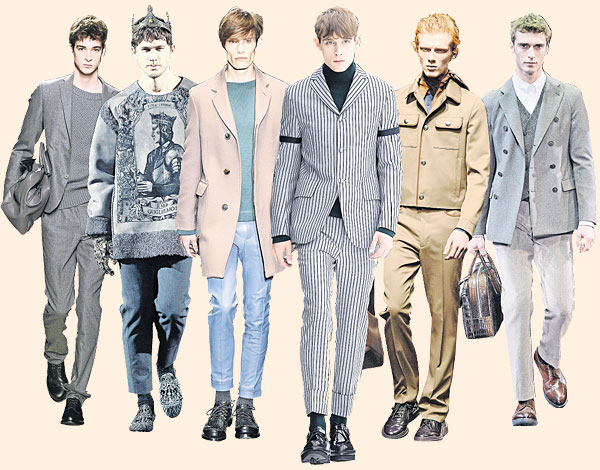Milan menswear shows lack energy

Simply sign up to the Life & Arts myFT Digest -- delivered directly to your inbox.
It’s strange the things you suddenly remember from school. Here’s what popped into my head during this week’s Milan menswear shows: the decline of the Roman Empire. Maybe it was seeing so many behemoth brands sending out collections trying to reaffirm or re-establish their reason for being. This was not a season for wild, outlandish trends. It felt at times like a fight for survival.
Three brands presented a renewed vision of their world with particular confidence. Gucci had the most to prove, having suffered a recent sales wobble, down 5.4 per cent year on year in the third quarter of 2013. Creative director Frida Giannini’s answer was a smart snapback to the neat silhouette that marked the beginning of her reign in 2006. Actually, it was an update: that 2006 man had a stronger shoulder, perhaps due to the bravado of pre-crash times, but for autumn/winter 2014 the look was softened with key themes: a coat that’s light enough to wear in autumn; a fine-gauge rollneck; shearling. It was a collection that created a template both commercial and desirable.
There was a similar sense of fresh familiarity at Prada, in a collection built from mostly unshowy pieces: lightweight coats, fine-knit T-shirts, utilitarian body jackets and neat trousers. Extravagance came from colour combinations, in shirts with contrasting collars, and quilted gilets that looked like body armour, sometimes lined with fur.
In the days afterwards, conversations often started with the question, “Did you actually like Prada?” The show provided no major novelty of the sort that sends fashion into a maelstrom, like the Hawaiian prints of the previous season or the chunky-soled shoes of the one before that. But I loved it for that very reason. Mrs Prada’s work can be just as powerful when it’s calm.
Another fact: if a guy on your block wore Bottega Veneta, you’d kind of want to know him. There’s an easy beat to creative director Tomas Maier’s clothing, one that gives the reassurance of precise but unassuming cut while also gently nudging the wardrobe forward. Maier was the best proponent of the elasticated-waist trouser, an idea that was all over London in the form of a trackpant obsession but which here was more often expressed as a tailored style.
To this I say hallelujah: I find it bizarre that men still mainly wear trousers that button up, but I also do not want to look like I am about to run a half marathon. Maier’s elasticated waist trousers were not just a gimmick; they would look great at a weekend brunch. Isn’t that sometimes all you want from clothes?
For brands that left their comfort zones, however, there were both successes and concerns. Versace is a house undergoing a rapid resurgence, with menswear sales rising strongly. The more outlandish the piece, apparently, the more men want to buy it. To this point, the show was purposefully entertaining – at one point, models came out in chaps, to show off the bandana print underwear beneath – but still contained a clever mix of product: T-shirts were printed with oversized, hand-drawn Medusa heads; a glitzy leather bomber was embroidered and beaded. Both will find an easy buyer.
By contrast, over at Dolce & Gabbana, the catwalk pieces felt isolated from the actual customer. Shearling sweatshirts printed with crests of Norman kings? Yes, really. The label has been printing historical images on clothing for a few seasons now and the limits of its appeal have been reached. There was no respite in tailoring, which had tricky lapels of a separate pattern to the rest of the suit. Please, engage with the contemporary world. Otherwise, the house risks diminishment.
Elsewhere, Giorgio Armani had a strong season, both in his main line and at Emporio Armani. Nothing surprised, and that was a boon. His city-smart signature fits well with the current informal mood. Tod’s debuted a full wardrobe for men – neat coats, quilted jackets – to go with its shoes and bags, a canny move. Jil Sander without Jil Sander was inevitably unsatisfying. Stefano Pilati’s second collection at Ermenegildo Zegna was less assured than his debut – perhaps he is working out how he fits in at the previously traditional house. Zegna’s junior line, Z Zegna, designed by Paul Surridge, put on a bravura show by not giving a damn. The energetic display of slim-fit suits was one of the best of the whole schedule.
Indeed, the pace of that Z Zegna show, the last I saw in the city, cast the rest of the shows in a pallid light. I had previously thought I was satisfied with what had been on offer. After seeing such a jolt of fashion, it made me realise we had been treading water. As it happened, I’d forgotten all I was ever told about the fall of the Roman Empire, and did some research during the shows. There are many conflicting theories for its decline, but one word stuck: malaise.
Comments